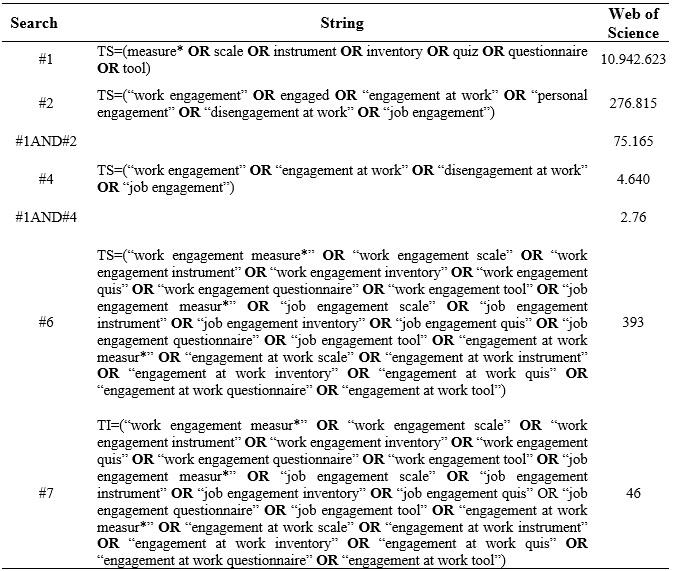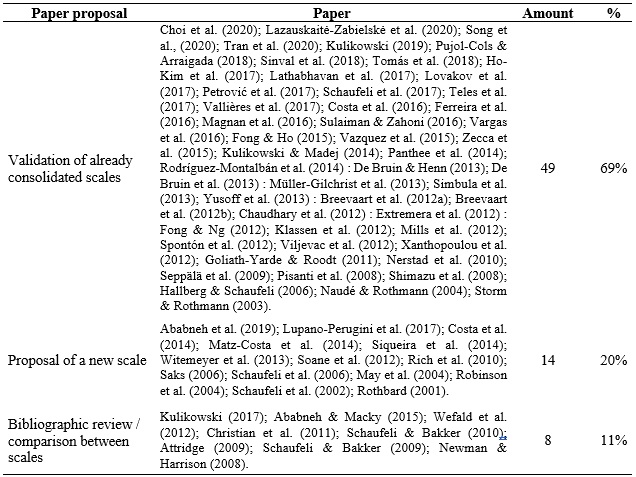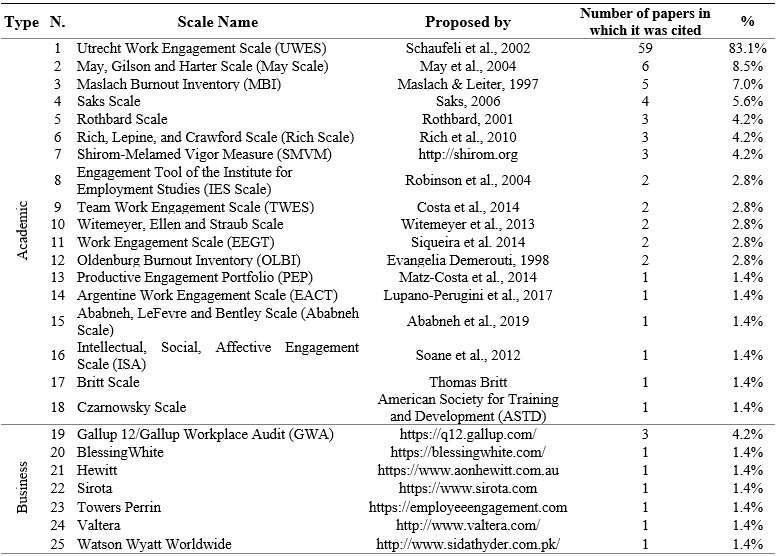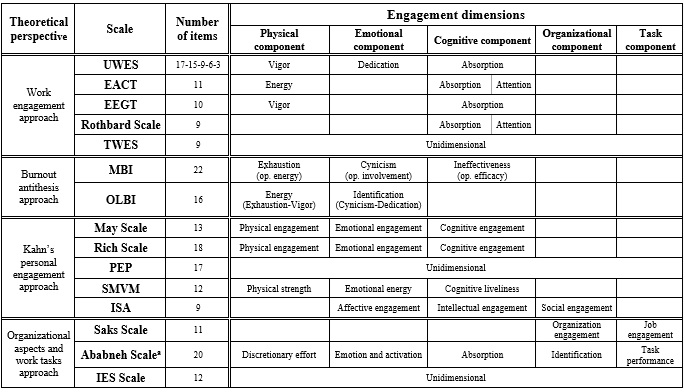Ababneh, O., Lefevre, M., & Bentley, T. (2019). Employee engagement: development of a new measure. International Journal Human Resources Development and Management, 19(2), 105-134. https://doi.org/10.1504/ijhrdm.2019.098623
Ababneh, O., & Macky, K. (2015). The meaning and measurement of employee engagement: a review of the literature. New Zealand Journal of Human Resource Management, 15(1), 1-20. Retrieved from http://www.nzjhrm.co.nz
Attridge, M. (2009). Measuring and managing employee work engagement: a review of the research and business literature. Journal of Workplace Behavioral Health, 24(4), 383-398. https://doi.org/10.1080/15555240903188398
Bakker, A., Albrecht, S. & Leiter, M. (2011). Work engagement: further reflections on the state of play. European Journal of Work and Organizational Psychology, 20(1), 74-88. https://doi.org/10.1080/1359432X.2010.546711
Bakker, A., & Demerouti, E. (2007). The job demands–resources model: state of the art. Journal of Managerial Psychology, 22(3), 309–328. https://doi.org/10.1108/02683940710733115
Breevaart, K., Bakker, A., & Demerouti, E. (2012a). The measurement of state work engagement: a multilevel factor analytic study. European Journal of Psychological Assessment, 28(4), 305-312. https://doi.org/10.1027/1015-5759/a000111
Breevaart, K., Bakker, A., & Demerouti, E. (2012b). Psychometrische eigenschappen van meetinstrumenten in dagboekonderzoek: illustratie aan de hand van bevlogenheid. Gedrag & Organisatie, 25(4), 419-432. Retrieved from https://www.gedragenorganisatie.nl/
Chaudhary, R., Rangnekar, S., & Barua, M. (2012). Psychometric Evaluation of Utrecht Work Engagement Scale in an Indian Sample. Asia-Pacific Journal of Management Research and Innovation, New York, 8(3), 343-350. https://doi.org/10.1177/2319510X1200800314
Choi, M., Suh, C., Choi, S., Lee, C., & Son, B. (2020). Validation of the Work Engagement Scale-3, used in the 5th Korean Working Conditions Survey. Annals of Occupational and Environmental Medicine, 32(1). https://doi.org/10.35371/aoem.2020.32.e27
Christian, M., Garza, A., & Slaughter, J. (2011). Work engagement: a quantitative review and test of its relations with task and contextual performance. Personnel Psychology, 67(1), 89-136. https://doi.org/10.5465/AMBPP.2007.26536346
Costa, P., Passos, A., & Bakker, A. (2014). Empirical validation of the team work engagement construct. Journal of Personnel Psychology, 13(1), 34-45. https://doi.org/10.1027/1866-5888/a000102
Costa, P., Passos, A., & Bakker, A. (2016). The work engagement grid: predicting engagement from two core dimensions. Journal of Managerial Psychology, 31(4), 774-789. https://doi.org/10.1108/JMP-11-2014-0336
De Bruin, G., & Henn, C. (2013). Dimensionality of the 9-Item Utrecht Work Engagement Scale (UWES-9). Psychological Reports, 112(3), 788-799. https://doi.org/10.2466/01.03.pr0.112.3.788-799
De Bruin, G., Hill, C., Henn, C., & Muller, K.-P. (2013). Dimensionality of the UWES-17: an item response modelling analysis. SA Journal of Industrial Psychology, 39(2), 1-8. https://doi.org/10.4102/sajip.v39i2.1148
Extremera, N., Sánchez-García, M., Durán, M., & Rey, L. (2012). Examining the psychometric properties of the Utrecht Work Engagement Scale in two Spanish multi-occupational samples. International Journal of Selection and Assessment, 20(1), 105-110. Retrieved from https://onlinelibrary.wiley.com/journal/14682389
Ferreira, M., Valentini, F., Damásio, B., Mourão, L., Porto, J., Chinelato, R., Novaes, V., Pereira, M. (2016). Evidências adicionais de validade da UWES-9 em amostras brasileiras. Estudos de Psicologia, 21(4), 435-445. https://doi.org/10.5935/1678-4669.20160042
Fong, T., & Ho, R. (2015). Dimensionality of the 9-item Utrecht Work Engagement Scale revisited: a Bayesian structural equation modeling approach. Journal of Occupational Health, 57(4), 353-358. https://doi.org/10.1539/joh.15-0057-ao
Fong, T., & Ng, S. (2012). Measuring engagement at work: validation of the Chinese version of the Utrecht Work Engagement Scale. International Journal of Behavioral Medicine, 19(3), 391-397. https://doi.org/10.1007/s12529-011-9173-6
Goliath-Yarde, L., & Roodt, G. (2011). Differential item functioning of the UWES-17 in South Africa. SA Journal of Industrial Psychology, 37(1), 1-11. https://doi.org/10.4102.sajip.v37i1.897
Hallberg, U., & Schaufeli, W. (2006). “Same same” but different? Can work engagement be discriminated from job involvement and organizational commitment? European Psychologist, 11(2), 119-127. https://doi.org/10.1027/1016-9040.11.2.119
Ho Kim, W., Park, J., & Kwon, B. (2017). Work engagement in South Korea. Psychological Reports, 120(3), 561-578. https://doi.org/10.1177/0033294117697085
Johnson, J. (2003). Toward a better understanding of the relationship between personality and individual job performance. In: M. Barrick & A. Ryan. Personality and work: Reconsidering the role of personality in organizations (pp. 83-120). Jossey-Bass.
Kahn, W. (1990). Psychological conditions of personal engagement and disengagement at work. Academy of Management Journal, 33(4), 692-724. https://doi.org/10.5465/256287
Kitchenham, B., & Charters, S. (2007). Guidelines for performing systematic literature reviews in software engineering. Keele: EBSE Technical Report. Retrieved from https://www.elsevier.com/__data/promis_misc/525444systematicreviewsguide.pdf
Klassen, R., Aldhafri, S., Mansfield, C., Purwanto, E., Siu, A., Wong, M., & Woods-McConney, A. (2012). Teacher’s engagement at work: an international validation study. The Journal of Experimental Education, 80(4), 317-337. https://doi.org/10.1080/00220973.2012.678409
Kulikowski, K. (2017). Do we all agree on how to measure work engagement? Factorial validity of Utrecht Work Engagement Scale as a standard measurement tool: a literature review. International Journal of Occupational Medicine and Environmental Health, 30(2), 161-175. https://doi.org/10.13075/ijomeh.1896.00947
Kulikowski, K. (2019). One, two or three dimensions of work engagement? Testing the factorial validity of the Utrecht work engagement scale (UWES) on a sample of Polish employees. International Journal of Occupational Safety and Ergonomics, 25(2), 241-249. https://doi.org/10.1080/10803548.2017.1371958
Kulikowski, K., & Madej, M. (2014). Zaangażowanie w pracę: problemy z pomiarem. Problemy Zarzdzania, 12(1), 99-112. https://doi.org/10.7172/1644-9584.45.7
Lathabhavan, R., Balasubramanian, S., & Natarajan, T. (2017). A psychometric analysis of the Utrecht Work Engagement Scale in Indian banking sector. Industrial and Commercial Training, 49(6), 296-302. https://doi.org/10.1108/ict-04-2017-0031
Lazauskaitė-Zabielskė, J., Urbanavičiūtė, I., & Balsienė, R. (2020). The structure of work engagement: a test of psychometric properties of the Lithuanian Version of the Utrecht Work Engagement Scale. European Journal of Psychological Assessment, 36, pp. 601-611. https://doi.org/10.1027/1015-5759/a000545
Lovakov, A., Agadullina, E., & Schaufeli, W. (2017). Psychometric properties of the Russian version of the Utrecht Work Engagement Scale (UWES-9). Psychology in Russia: State of the Art, 10(1), 145-162. https://doi.org/10.11621/pir.2017.0111
Lupano-Perugini, M., de la Iglesia, G., Castro-Solano, A., & Fernández-Liporace, M. (2017). Validación de una Escala sobre Work Engagement. Perfiles asociados a alta Performance y Satisfacción Laboral. Ciencias Psicológicas, 11(2), 127-137. https://doi.org/10.22235/cp.v11i2.1482
Magnan, E., Vazquez, A., Pacico, J., & Hutz, C. (2016). Normatização da versão Brasileira da Escala Utrecht de Engajamento no Trabalho. Avaliação Psicológica, 15(2), 133-140. https://doi.org/10.15689/ap.2016.1502.01
Maslach, C., & Leiter, M. (1997). The truth about burnout: How organizations cause personal stress and what to do about it. Jossey Bass.
Maslach, C., Schaufeli, W., & Leiter, M. (2001). Job burnout. Annual Review of Psychology, 52, 397-422. https://doi.org/10.1111/1467-8721.01258
Matz-Costa, C., James, J., Ludlow, L., Brown, M., Besen, E., & Johnson, C. (2013). The meaning and measurement of productive engagement in later life. Social Indicators Research, 118(3), 1293-1314. https://doi.org/10.1007/s11205-013-0469-6
May, D., Gilson, R., & Harter, L. (2004). The psychological conditions of meaningfulness, safety and availability and the engagement of the human spirit at work. Journal of Occupational and Organizational Psychology, 77(1), 11-37. https://doi.org/10.1348/096317904322915892
Mills, M., Culbertson, S., & Fullagar, C. (2012). Conceptualizing and measuring engagement: an analysis of the Utrecht Work Engagement Scale. Journal of Happiness Studies, 13(3), 519-545. https://doi.org/10.1007/s10902-011-9277-3
Moher, D., Liberati, A., Tetzlaff, J., Altman, D., & The PRISMA Group. (2009). Preferred reporting items for systematic reviews and meta-analyses: The PRISMA statement. PLoS Medicine, 6(7), 1-6. https://doi.org/10.1371/journal.pmed.1000097
Müller-Gilchrist, R., Exequel-Pérez-Villalobos, C., & Ramirez-Fernández, L. (2013). Estructura factorial y consistencia interna de la Utrech Work Engagement Scale (UWES) 17 entre trabajadores sanitarios de Chile. Liberabit, 19(2), 163-171. Retrieved from http://revistaliberabit.com/es/publicaciones/
Naudé, J., & Rothmann, S. (2004). The validation of the Utrecht Work Engagement Scale for emergency medical technicians in Gauteng. South African Journal of Economic and Management Sciences. .(3), 459-468. https://doi.org/10.4102/sajems.v7i3.1356
Nerstad, C., Richardsen, A., & Martinussen, M. (2010). Factorial validity of the Utrecht Work Engagement Scale (UWES) across occupational groups in Norway. Scandinavian Journal of Psychology, 51(4), 326-333. https://doi.org/10.1111/j.1467-9450.2009.00770.x
Newman, D., & Harrison, D. (2008). Been there, bottled that: are state and behavioral work engagement new and useful construct "wines"? Industrial and Organizational Psychology, 1(1), 31-35. Retrieved from https://onlinelibrary.wiley.com/journal/17549434
Panthee, B., Shimazu, A., & Kawakami, N. (2014). Validation of Nepalese version of Utrecht Work Engagement Scale. Journal of Occupational Health, 56(6), 421–429. https://doi.org/10.1539/joh.14-0041-ao
Petrović, I., Vukelić, M., & Čizmić, S. (2017). Work Engagement in Serbia: psychometric properties of the Serbian version of the Utrecht Work Engagement Scale (UWES). Frontiers in Psychology, 8(1799), 1-12. https://doi.org/10.3389/fpsyg.2017.01799
Pisanti, R., Paplomatas, A., & Bertini, M. (2008). Misurare le dimensioni positive nel lavoro in sanità: un contributo all’adattamento italiano della UWES – Utrecht Work Engagement Scale. Giornale italiano di medicina del lavoro ed ergonomia, 30(1), 111-119. Retrieved from https://www.gimle.biz/
Pujol-Cols, L., & Arraigada, M. (2018). Propiedades psicométricas de la versión corta de la Utrecht Work Engagement Scale en trabajadores argentinos. Pensamiento Psicológico, 16(2), 31-45. https://doi.org/10.11144/javerianacali.PPSI16-2.ppvc
Rich, B., Lepine, J., & Crawford, E. (2010). Job engagement: antecedents and effects on job performance. Academy of Management Journal, 63(3), 617-635. https://doi.org/10.5465/AMJ.2010.51468988
Robinson, D., Perryman, S., & Hayday, S. (2004). The drivers of employee engagement. Falmer: IES – Institute For Employment Studies. Retrieved from https://www.employment-studies.co.uk/system/files/resources/files/408.pdf
Rodríguez-Montalbán, R., Martínez-Lugo, M., & Sánchez-Cardona, I. (2014) Análisis de las propiedades psicométricas de la Utrecht Work Engagement Scale en una muestra de trabajadores en Puerto Rico. Universitas Psychologica, 13(4), 1255-1266. https://doi.org/10.11144/Javeriana.UPSY13-4.appu
Rothbard, N. (2001). Enriching or depleting? The dynamics of engagement in work and family roles. Administrative Science Quarterly, 46(4), 655-684. https://doi.org/10.2307/3094827
Saks, A. (2006). Antecedents and consequences of employee engagement. Journal of Managerial Psychology, 21(7), 600-619. https://doi.org/10.1108/02683940610690169
Schaufeli, W., & Bakker, A. (2009). UWES: Utrecht Work Engagement Scale – Escala de Engagemento no Trabalho de Utrecht. (R. Angst, A. M. T. Benevides-Pereira, P. C. Porto-Martins, Trad). Utrecht: GEPEB – Grupo de Estudos e Pesquisas sobre Estresse e Burnout. Retrieved from https://www.wilmarschaufeli.nl/publications/Schaufeli/Test%20Manuals/Test_manual_UWES_Brazil.pdf
Schaufeli, W., & Bakker, A. (2010). Defining and measuring work engagement: bringing clarity to the concept. In: A. Bakker & M. Leiter. Work engagement: A handbook of essential theory and research (pp. 10-24). Psychology Press.
Schaufeli, W., Bakker, A., & Salanova, M. (2006). The measurement of work engagement with a short questionnaire: a cross-national study. Educational and Psychological Measurement, 66(4), 701-716. https://doi.org/10.1177/0013164405282471
Schaufeli, W., Salanova, M., Gonzalez-Roma, V., & Bakker, A. (2002). The measurement of engagement and burnout: a two sample confirmatory factor analytic approach. Journal of Happiness Studies, 3(1), 71-92. Retrieved from https://link.springer.com/journal/10902
Schaufeli, W., Shimazu, A., Hakanen, J., Salanova, M., & De Witte, H. (2017). An ultra-short measure for work engagement: the UWES-3 validation across five countries. European Journal of Psychological Assessment, 35(4), 577-591. https://doi.org/10.1027/1015-5759/a000430
Seligman, M., & Csikszentmihalyi, M. (2000). Positive psychology: an introduction. American Psychologist, 55(1), 5-14. https://doi.org/10.1037/0003-066X.55.1.5
Seppälä, P., Mauno, S., Feldt, T., Hakanen, J., Kinnunen, U., Tolvanen, A., & Schaufeli, W. (2009). The construct validity of the Utrecht Work Engagement Scale: multisample and longitudinal evidence. Journal of Happiness Studies, 10(4), 459-481. https://doi.org/10.1007/s10902-008-9100-y
Shimazu, A., Schaufeli, W., Kosugi, S., Suzuki, A., Nashiwa, H., Kato, A., Sakamoto, M., Irimajiri, H., Amano, S., Hirohata, K., Goto, R., Kitaoka-Higashiguchi, K. (2008). Work Engagement in Japan: validation of the Japanese version of the Utrecht Work Engagement Scale. Applied Psychology – An International Review, 57(3), 510-523. https://doi.org/10.1111/j.1464-0597.2008.00333.x
Shuck, B. (2011). Four emerging perspectives of employee engagement: an integrative literature review. Human Resource Development Review, 10(3), 304-328. https://doi.org/10.1177/1534484311410840
Simbula, S., Guglielmi, D., Schaufeli, W., & Depolo, M. (2013). An Italian validation of the Utrecht Work Engagement Scale: characterization of engaged groups in a sample of schoolteachers. Bollettino di Psicologia Applicata, (268), 43-54. Retrieved from http://www.giuntipsy.it/bpa/la-rivista/
Simpson, M. (2009). Engagement at work: a review of the literature. International Journal of Nursing Studies, 46(7), 1012–1024. https://doi.org/10.1016/j.ijnurstu.2008.05.003
Sinval, J., Pasian, S., Queirós, C., & Marôco, J. (2018). Brazil-Portugal transcultural adaptation of the uwes-9: internal consistency, dimensionality, and measurement invariance. Frontiers in Psychology, 9, 1-18. https://doi.org/10.3389/fpsyg.2018.00353
Siqueira, M., Martins, M. C. F., Orengo, V., & Souza, W. (2014). Engajamento no trabalho. In: M. Siqueira (Org.). Novas Medidas do Comportamento Organizacional: Ferramentas de diagnóstico e de gestão (pp. 147-156). Artmed.
Soane, E., Truss, C., Alfes, K., Shantz, A., Rees, C., & Gatenby, M. (2012). Development and application of a new measure of employee engagement: the ISA Engagement Scale. Human Resource Development International, 15(5), 529-547. https://doi.org/10.1080/13678868.2012.726542
Song, H.-D., Hong, A., & Jo, Y. (2020). Psychometric investigation of the Utrecht Work Engagement Scale-17 using the rasch measurement model. Psychological Reports, 003329412092249.
https://doi:10.1177/0033294120922494
Spontón, C., Medrano, L., Maffe, L., Spontón, M., & Castellano, E. (2012). Validación del cuestionario de engagement UWES a la población de trabajadores de Córdoba, Argentina. Liberabit, 18(2), 147-154. Retrieved from http://revistaliberabit.com/es/publicaciones/
Storm, K., & Rothmann, S. (2003). A psychometric analysis of the Utrecht work engagement scale in the South African police service. SA Journal of Industrial Psychology, 29(4), 62-70. https://doi.org/10.4102/sajip.v29i4.129
Sulaiman, W., & Zahoni, N. (2016). Validation of the Utrecht Work Engagement Scale (UWES) in the Malaysian context. International Journal of Social Science and Humanity, 6(9), 672-676. https://doi.org/10.18178/ijssh.2016.6.9.730
Teles, H., Ramalho, N., Ramalho, V., & Ribeiro, S. (2017). Adaptação e validação da Utrecht Work Engagement Scale (UWES) aplicada a assistentes sociais em Portugal. Revista Portuguesa de Investigação Comportamental e Social, 3(2), 10-20. https://doi.org/10.7342/ismt.rpics.2017.3.2.52
Tomás, J., de los Santos, S., Georgieva, S., Enrique, S., & Fernández, I. (2018). Utrecht Work Engagement Scale in Dominican teachers: dimensionality, reliability, and validity. Revista de Psicología del Trabajo y de las Organizaciones, 34(2), 89-93. https://doi.org/10.5093/jwop2018a11
Tran, T., Watanabe, K., Imamura, K., Nguyen, H., Sasaki, N., Kuribayashi, K., … Kawakami, N. (2020). Reliability and validity of the Vietnamese version of the 9‐item Utrecht Work Engagement Scale. Journal of Occupational Health, 62(1). https://doi:10.1002/1348-9585.12157
Vallières, F., McAuliffe, E., Hyland, P., Galligan, M., & Ghee, A. (2017). Measuring work engagement among community health workers in Sierra Leone: validating the Utrecht Work Engagement Scale. Revista de Psicología del Trabajo y de las Organizaciones, 33(1), 41-46. https://doi.org/10.1016/j.rpto.2016.12.001
Vargas, C., Gumbau, S., Sánchez, A., & Bannack, M. (2016). Validación de la escala UWES-9 en profesionales de la salud en México. Pensamiento Psicológico, 14(2), 89-100. https://doi.org/10.11144/javerianacali.PPSI14-2.veup
Vazquez, A., Magnan, E., Pacico, J., Hutz, C., & Schaufeli, W. (2015). Adaptation and validation of the Brazilian version of the Utrecht Work Engagement Scale. Psico-USF, 20(2), 207-217. https://doi.org/10.1590/1413-82712015200202
Viljevac, A., Cooper-Thomas, H., & Saks, A. (2012). An investigation into the validity of two measures of work engagement. The International Journal of Human Resource Management, 23(17), 3692-3709. https://doi.org/10.1080/09585192.2011.639542
Wefald, A., Mills, M., Smith, M., & Downey, R. (2012). A comparison of three job engagement measures: examining their factorial and criterion-related validity. Applied Psychology – Health and Well Being, 4(1), 67-90. https://doi.org/10.1111/j.1758-0854.2011.01059.x
Witemeyer, H., Ellen, P., & Straub, D. (2013). Validating a practice-informed definition of employee engagement. In: Third International Conference On Engaged Management Scholarship, Atlanta, EUA. Retrieved from https://papers.ssrn.com/sol3/papers.cfm?abstract_id=2327895
Xanthopoulou, D., Bakker, A., Kantas, A., & Demerouti, E. (2012). Measuring burnout and work engagement: factor structure, invariance, and latent mean differences across Greece and the Netherlands. International Journal of Business Science and Applied Management, 7(2), 40-52. Retrieved from http://www.business-and-management.org/issues.php
Yusoff, R., Ali, A., Khan, A., & Bakar, S. (2013). Psychometric evaluation of Utrecht Work Engagement Scale among academic staff in universities of Pakistan. World Applied Sciences Journal, 28(11), 1555-1560. https://doi.org/10.5829/idosi.wasj.2013.28.11.2014
Zecca, G., Györkös, C., Becker, J., Massoudi, K., de Bruin, G., & Rossier, J. (2015). Validation of the French Utrecht Work Engagement Scale and its relationship with personality traits and impulsivity. European Review of Applied Psychology, 65(1), 19-28. https://doi.org/10.1016/j.erap.2014.10.003














